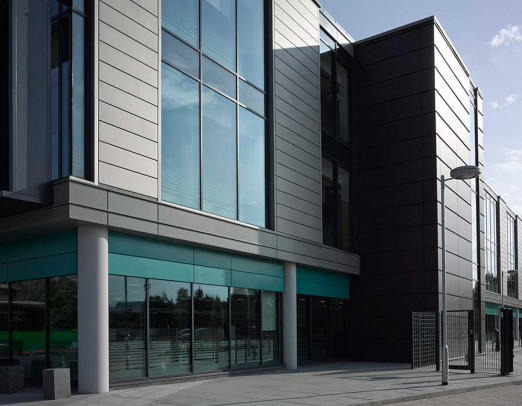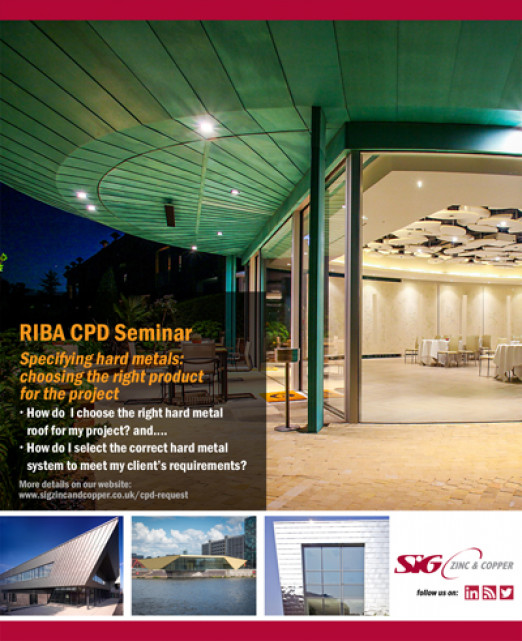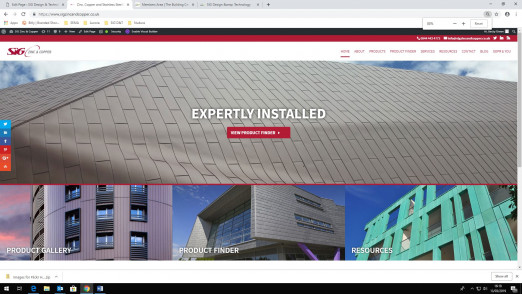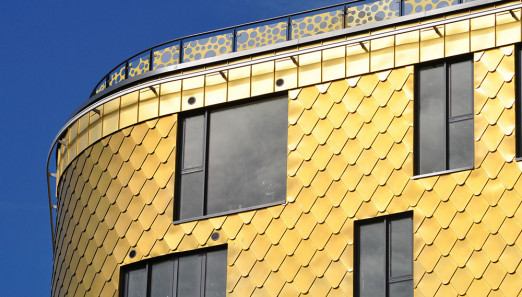Bolton College has opened the doors of a brand new state-of-the-art STEM Centre to provide support for learning in Science, Technology, Engineering and Maths. The new 1800m2 centre completes the Deane Road campus and aims to increase aspiration and motivation amongst the town’s young people by offering different options following secondary school.
A key component of Bolton’s Skills Strategy, the STEM Centre has real life working environments and increased laboratory space to help learners follow a range of career pathways including environmental science, sustainable technologies, engineering and manufacturing. New automotive workshops will train highly skilled technicians and provide progression to local university provision.
About the Cladding
The STEM Centre features a futuristic angled façade to Deane Road, which forms a distinctive corner to the campus. This feature is articulated through the use of angled standing seam zinc cladding completed in Nedzink NOVA. Cladding and window placement work together to emphasise the building form, and whilst the glazing breaks up the elevation, the seams also change direction in the soffits, combining together to an appealing whole.
Installation
Specialist subcontractor Longworth Building Services was employed to carry out the zinc cladding and associated substrate works. The Nedzink NOVA standing seam cladding was applied to a plywood surface, brackets and rails and insulation, fixed into an SFS frame prepared by the main contractor.
The main challenge that Longworth faced was the requirement for angled, rather than vertical seams. Their most skilled craftsmen were used on this project to ensure that the panels were kept at the same angle, and there was no creep with the joints.
The architect also wished to reduce the ‘oil canning’ or quilting effect on the panels. Some wobble is always present in zinc standing seam cladding, due to the way it is prepared, but this can be reduced if required by reducing the seam centres. Commonly zinc cladding seam centres will be 500-600mm but in the case of Bolton College these have been reduced to 425mm.
During the installation process, the zinc coils were sent direct to site from the supplier. This reduced delivery distances and transport costs and all deliveries were on time. Coils were stored in secure dry conditions until they were required for fabrication.
All the panels and flashings were manufactured on site to cutting schedules calculated by Longworth’s designers. Due to the zinc being 100% recyclable, Longworth were able to bring limited off cuts and remaining coils back to their workshop for re-use on other projects, resulting in 0% waste of the zinc. This service is also available direct from SIG Zinc and Copper who can provide bespoke sizes to site where more appropriate to the contract, again minimising waste and saving money.
Longworth carried out the site installation using in house labour, pairing up two experienced craftsmen with final year apprentices. Towards the end of the project, the apprentices were given their own area of the work to complete which gave them valuable experience under the guidance of the foreman.
Advice for Architects on Zinc Cladding
Longworth’s Contracts Manager Lee Smith has worked with NedZink on many projects and has 16 years experience working with zinc. ‘NedZink is very easy to work with, a little softer and not as brittle as other products. This makes folding the material for swept ends and dressings easier.’
For architects wanting to use zinc for cladding, Lee advises, “Always consider properly building and ventilating the substrate for the cladding,” he says. The FTMRC provide standard details, but you must make sure the manufacturers requirements are complied with as well. Get your supplier to provide details and fully understand how the system works to make sure you are covered. Correct installation is essential.”
SIG Design & Technology takes the risk out of roof design, offering a genuinely independent choice of waterproofing for flat, green, zinc and copper roofs. Designs are covered by our PI insurance and we’re part of SIG plc, a FTSE250 company. Our blog at www.singleply.co.uk/blog explores some of your common problems in roof design and system choice, or book our new RIBA CPDs, ‘A Structured Approach to Roof Specification & Design’ and ‘Specifying Hard Metals: Choosing the Right Product for the Project’.







